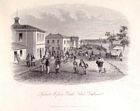- Alternative Names
- Ballaarat
Gold was found at Ballarat by John Dunlop and James Regan in August 1851, followed by other finds at Golden Point to the north-west. The rush was short-lived but, with deep lead mining, a new boom began. The rich yields led Ballarat’s population to rise steadily and a more settled community meant that wealth from the goldfield was re-invested in the locality. In 1858, a party of Cornishmen found the Welcome Nugget, weighing 2,217 ounces, a then record.
Sluicing ventures were mainly unprofitable but the shallow deposits were reworked by the Chinese, who made up a significant proportion of the mining population in the late 1850s and 1860s.
At the end of 1854 the Eureka Rebellion, a brief demonstration of armed conflict again injustice, took place. Factors leading to it included the hated licence fee and the unjust administration system used by the Colonial Government to control the goldfields population.

.jpg)








